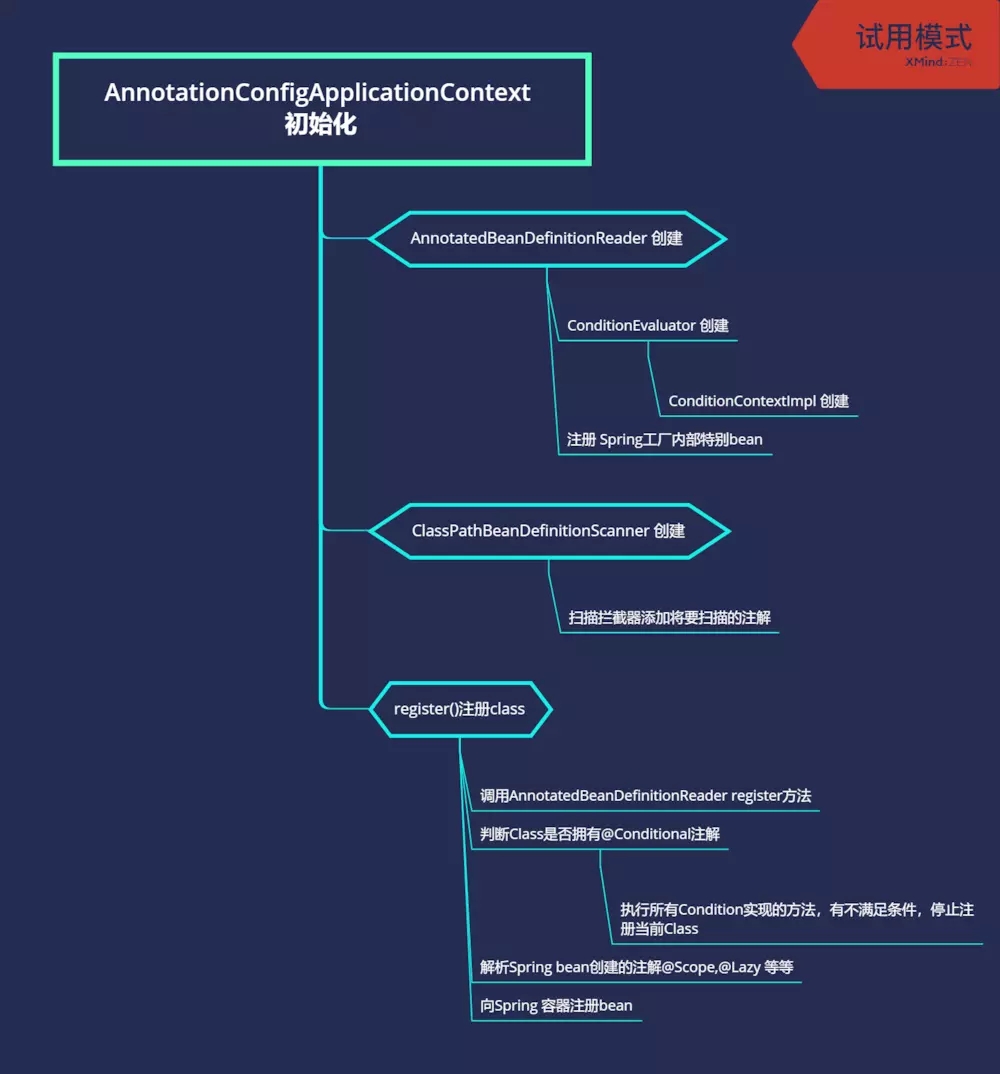怎么在Spring IOC中利用注解启动?相信很多没有经验的人对此束手无策,为此本文总结了问题出现的原因和解决方法,通过这篇文章希望你能解决这个问题。
Spring 基于注解启动
主要有两个Class实现注解启动
AnnotationConfigApplicationContext
AnnotationConfigWebApplicationContext
我们以AnnotationConfigApplicationContext 为研究对象

AnnotationConfigApplicationContext.png
引入Spring 最小依赖
<dependency>
<groupId>org.springframework</groupId>
<artifactId>spring-context</artifactId>
<version>${spring.version}</version>
</dependency>编写器启动代码
public static void main(String[] args) {
AnnotationConfigApplicationContext applicationContext = new AnnotationConfigApplicationContext();
applicationContext.register(BeanConfig.class);
applicationContext.refresh();
Date date = applicationContext.getBean("date",Date.class);
System.out.println(date);
}AnnotationConfigApplicationContext 构造函数
public AnnotationConfigApplicationContext() {
//负责注册Class ,读取器
this.reader = new AnnotatedBeanDefinitionReader(this);
//负责扫描指定类路径下的Class,注册bean
this.scanner = new ClassPathBeanDefinitionScanner(this);
}AnnotatedBeanDefinitionReader 构造方法
public AnnotatedBeanDefinitionReader(BeanDefinitionRegistry registry) {
this(registry, getOrCreateEnvironment(registry));
}
public AnnotatedBeanDefinitionReader(BeanDefinitionRegistry registry, Environment environment) {
Assert.notNull(registry, "BeanDefinitionRegistry must not be null");
Assert.notNull(environment, "Environment must not be null");
this.registry = registry;
//初始化ConditionEvaluator
this.conditionEvaluator = new ConditionEvaluator(registry, environment, null);
/** 在給定的注册表中註冊所有相关的post processors
* 判断容器是否已经存在给定注册表的bean,如果没有注册bean,并将bean放入容器中
* 把所有的处理处理器列出来
* ConfigurationClassPostProcessor 內部管理的配置注解处理器
* AutowiredAnnotationBeanPostProcessor 内部管理@Autowired 的处理器
* RequiredAnnotationBeanPostProcessor @Required的处理器
* CommonAnnotationBeanPostProcessor JSR-250注解处理器 ,先判断是否支持jsr,如果支持注册
* PersistenceAnnotationBeanPostProcessor JPA管理 先使用类加载器查找是否存在,如果有这个包则注册
* EventListenerMethodProcessor @EventListener的处理器
* DefaultEventListenerFactory 管理EventListenerFactory处理器
*/
AnnotationConfigUtils.registerAnnotationConfigProcessors(this.registry);
}ConditionEvaluator 这个对象干什么,点击进去
public ConditionEvaluator(@Nullable BeanDefinitionRegistry registry,
@Nullable Environment environment, @Nullable ResourceLoader resourceLoader) {
this.context = new ConditionContextImpl(registry, environment, resourceLoader);
}
//ConditionContextImpl 实现了ConditionContext接口,ConditionEvaluator静态内部类
public ConditionContextImpl(@Nullable BeanDefinitionRegistry registry,
@Nullable Environment environment, @Nullable ResourceLoader resourceLoader) {
this.registry = registry;
this.beanFactory = deduceBeanFactory(registry);
this.environment = (environment != null ? environment : deduceEnvironment(registry));
this.resourceLoader = (resourceLoader != null ? resourceLoader : deduceResourceLoader(registry));
this.classLoader = deduceClassLoader(resourceLoader, this.beanFactory);
}可以知道ConditionEvaluator使用外部传参的方法初始化了Spring容器顶级对象
BeanFactory,Environment,ResourceLoader,ClassLoader。在将这些传给ConditionContextImpl为接下来的解析@Conditional注解做好准备
ClassPathBeanDefinitionScanner构造函数
public ClassPathBeanDefinitionScanner(BeanDefinitionRegistry registry) {
this(registry, true);
}
public ClassPathBeanDefinitionScanner(BeanDefinitionRegistry registry, boolean useDefaultFilters) {
this(registry, useDefaultFilters, getOrCreateEnvironment(registry));
}
public ClassPathBeanDefinitionScanner(BeanDefinitionRegistry registry, boolean useDefaultFilters,
Environment environment) {
this(registry, useDefaultFilters, environment,
(registry instanceof ResourceLoader ? (ResourceLoader) registry : null));
}
public ClassPathBeanDefinitionScanner(BeanDefinitionRegistry registry, boolean useDefaultFilters,
Environment environment, @Nullable ResourceLoader resourceLoader) {
Assert.notNull(registry, "BeanDefinitionRegistry must not be null");
this.registry = registry;
if (useDefaultFilters) {
registerDefaultFilters();
}
setEnvironment(environment);
setResourceLoader(resourceLoader);
}
protected void registerDefaultFilters() {
this.includeFilters.add(new AnnotationTypeFilter(Component.class));
ClassLoader cl = ClassPathScanningCandidateComponentProvider.class.getClassLoader();
try {
this.includeFilters.add(new AnnotationTypeFilter(
((Class<? extends Annotation>) ClassUtils.forName("javax.annotation.ManagedBean", cl)), false));
logger.debug("JSR-250 'javax.annotation.ManagedBean' found and supported for component scanning");
}
catch (ClassNotFoundException ex) {
}
try {
this.includeFilters.add(new AnnotationTypeFilter(
((Class<? extends Annotation>) ClassUtils.forName("javax.inject.Named", cl)), false));
logger.debug("JSR-330 'javax.inject.Named' annotation found and supported for component scanning");
}
catch (ClassNotFoundException ex) {
// JSR-330 API not available - simply skip.
}
}绕了地球几圈了,其实就是将Spring 顶级接口 Environment,ResourceLoader赋值,使用默认注解过滤器,首先将@Component加入List中,判断当前环境是否支持JSR-250,JSR-330,相应加入过滤器中。也就是这个扫描器默认只扫描@Component或者JSR-250,JSR-330的标记的Class。
applicationContext.register(BeanConfig.class)
public void register(Class<?>... annotatedClasses) {
Assert.notEmpty(annotatedClasses, "At least one annotated class must be specified");
this.reader.register(annotatedClasses); //调用 刚刚初始化读取器
}
|
============================AnnotatedBeanDefinitionReader 读取器代码======================================================================================================
public void register(Class<?>... annotatedClasses) {
for (Class<?> annotatedClass : annotatedClasses) {
registerBean(annotatedClass);
}
}
public void registerBean(Class<?> annotatedClass) {
doRegisterBean(annotatedClass, null, null, null);
}
/**
*从给定的bean解析Class给定的注解,执行相应的初始化,保存到Spring容器中
*/
<T> void doRegisterBean(Class<T> annotatedClass, @Nullable Supplier<T> instanceSupplier, @Nullable String name,
@Nullable Class<? extends Annotation>[] qualifiers, BeanDefinitionCustomizer... definitionCustomizers) {
//根据Class的Annotated 得出元数据 AnnotationMetadata
AnnotatedGenericBeanDefinition abd = new AnnotatedGenericBeanDefinition(annotatedClass);
/**
* 判断注册的Class 是否包含@Conditional注解,如果有获取全部value,放入List中
* 排序后,遍历所有的Conditiion的实现,使用反射获取对象,执行matches方法,
* 如果发现有返回false,中断循环直接返回true,
*/
if (this.conditionEvaluator.shouldSkip(abd.getMetadata())) { //如果 @Conditional条件不满足,不进行注册
return;
}
abd.setInstanceSupplier(instanceSupplier);
//解析Class是否有@Scope,解析@Scope注解返回ScopeMetadata对象,没有直接返回空
ScopeMetadata scopeMetadata = this.scopeMetadataResolver.resolveScopeMetadata(abd);
abd.setScope(scopeMetadata.getScopeName());
//判断注解上Value是否有值,有就使用这个作为BeanName,没有则取类名
String beanName = (name != null ? name : this.beanNameGenerator.generateBeanName(abd, this.registry));
//继续解析AnnotationMetadata的@Lazy,@Primary,@DependsOn,@Role,@Description的注解,放入结果放入对象的属性中
AnnotationConfigUtils.processCommonDefinitionAnnotations(abd);
//这个类只是BeanDefinition 包装类
BeanDefinitionHolder definitionHolder = new BeanDefinitionHolder(abd, beanName);
//是否需要代理类,如果是则修改内部属性,重新生成BeanDefinition 对象
definitionHolder = AnnotationConfigUtils.applyScopedProxyMode(scopeMetadata, definitionHolder, this.registry);
//调用DefaultListableBeanFactory.registerBeanDefinition的方法,做一些安全性校验再,将definitionHolder 放入register容器中
BeanDefinitionReaderUtils.registerBeanDefinition(definitionHolder, this.registry);
}这个方法就是将注册的Bean,解析Class上的注解,初始化注解数据,做相应处理,转化成BeanDefinition ,放入Spring 容器中保存起来。
我们看下BeanDefinition是怎么实现注册到Spring的容器中,主要由DefaultListableBeanFactory.registerBeanDefinition来实现
public void registerBeanDefinition(String beanName, BeanDefinition beanDefinition)
throws BeanDefinitionStoreException {
Assert.hasText(beanName, "Bean name must not be empty");
Assert.notNull(beanDefinition, "BeanDefinition must not be null");
if (beanDefinition instanceof AbstractBeanDefinition) {
try {
//对beanDefinition 进行校验判断MethodOverrides不能为空,必须拥有工厂方法
((AbstractBeanDefinition) beanDefinition).validate();
}
catch (BeanDefinitionValidationException ex) {
throw new BeanDefinitionStoreException(beanDefinition.getResourceDescription(), beanName,
"Validation of bean definition failed", ex);
}
}
BeanDefinition oldBeanDefinition;
oldBeanDefinition = this.beanDefinitionMap.get(beanName);
if (oldBeanDefinition != null) {
//这个方法是判断是否允许出现重名bean,并且是不同的定义bean,是否可以覆盖前者
if (!isAllowBeanDefinitionOverriding()) {
throw new BeanDefinitionStoreException(beanDefinition.getResourceDescription(), beanName,
"Cannot register bean definition [" + beanDefinition + "] for bean '" + beanName +
"': There is already [" + oldBeanDefinition + "] bound.");
}
else if (oldBeanDefinition.getRole() < beanDefinition.getRole()) {
// e.g. was ROLE_APPLICATION, now overriding with ROLE_SUPPORT or ROLE_INFRASTRUCTURE
if (this.logger.isWarnEnabled()) {
this.logger.warn("Overriding user-defined bean definition for bean '" + beanName +
"' with a framework-generated bean definition: replacing [" +
oldBeanDefinition + "] with [" + beanDefinition + "]");
}
}
else if (!beanDefinition.equals(oldBeanDefinition)) {
if (this.logger.isInfoEnabled()) {
this.logger.info("Overriding bean definition for bean '" + beanName +
"' with a different definition: replacing [" + oldBeanDefinition +
"] with [" + beanDefinition + "]");
}
}
else {
if (this.logger.isDebugEnabled()) {
this.logger.debug("Overriding bean definition for bean '" + beanName +
"' with an equivalent definition: replacing [" + oldBeanDefinition +
"] with [" + beanDefinition + "]");
}
}
this.beanDefinitionMap.put(beanName, beanDefinition);
}
else {
//调用alreadyCreated.isEmpty(),alreadyCreated Set对象,保存已经创建beanName
//文档中表示created,跟这里注册应该不是同一个行为,这个要看到后面才知道什么意思
if (hasBeanCreationStarted()) {
synchronized (this.beanDefinitionMap) {//更新数据
this.beanDefinitionMap.put(beanName, beanDefinition);
List<String> updatedDefinitions = new ArrayList<>(this.beanDefinitionNames.size() + 1);
updatedDefinitions.addAll(this.beanDefinitionNames);
updatedDefinitions.add(beanName);
this.beanDefinitionNames = updatedDefinitions;
if (this.manualSingletonNames.contains(beanName)) {
Set<String> updatedSingletons = new LinkedHashSet<>(this.manualSingletonNames);
updatedSingletons.remove(beanName);
this.manualSingletonNames = updatedSingletons;
}
}
}
else {
//Spring beanDefinition 容器,一个Map转载
this.beanDefinitionMap.put(beanName, beanDefinition);
//保存beanName,主要用于记录每个bean注册顺序
this.beanDefinitionNames.add(beanName);
//删除单例,注册成一个普通bean
this.manualSingletonNames.remove(beanName);
}
this.frozenBeanDefinitionNames = null;
}
if (oldBeanDefinition != null || containsSingleton(beanName)) {
//更新Spring容器里beanName
resetBeanDefinition(beanName);
}
}将beanDefinition注册到Spring容器中,并没有太多复杂的逻辑,只是做一些安全性的检查。
BeanDefinition
一个BeanDefinition描述了一个bean的实例,包括属性值,构造方法参数值和继承自它的类的更多信息。BeanDefinition仅仅是一个最简单的接口,主要功能是允许BeanFactoryPostProcessor 例如PropertyPlaceHolderConfigure 能够检索并修改属性值和别的bean的元数据(译注)
Spring 容器beanDefinition主要分为RootBeanDefinition,AnnotatedGenericBeanDefinition这两种
RootBeanDefinition Spring Factory中的特定bean
AnnotatedGenericBeanDefinition 用户自定义bean
Spring 启动流程总结

AnnotationConfigApplicationContext 初始化.png
这些BeanDefinition只是放入到Spirng 容器中,并没有进行任何初始化对象的操作,真正的IOC操作都在refresh(),这个方法有空再进行分析。
看完上述内容,你们掌握怎么在Spring IOC中利用注解启动的方法了吗?如果还想学到更多技能或想了解更多相关内容,欢迎关注亿速云行业资讯频道,感谢各位的阅读!
亿速云「云服务器」,即开即用、新一代英特尔至强铂金CPU、三副本存储NVMe SSD云盘,价格低至29元/月。点击查看>>
免责声明:本站发布的内容(图片、视频和文字)以原创、转载和分享为主,文章观点不代表本网站立场,如果涉及侵权请联系站长邮箱:is@yisu.com进行举报,并提供相关证据,一经查实,将立刻删除涉嫌侵权内容。